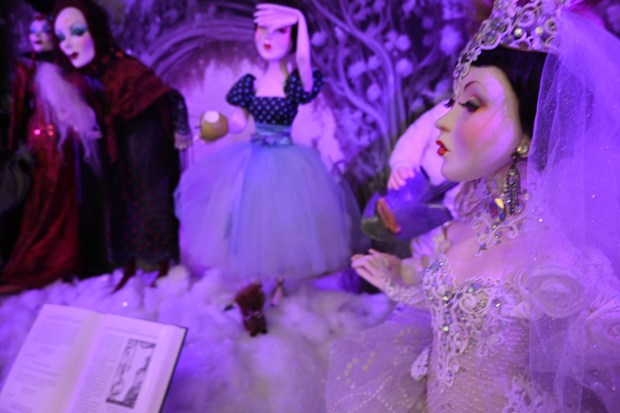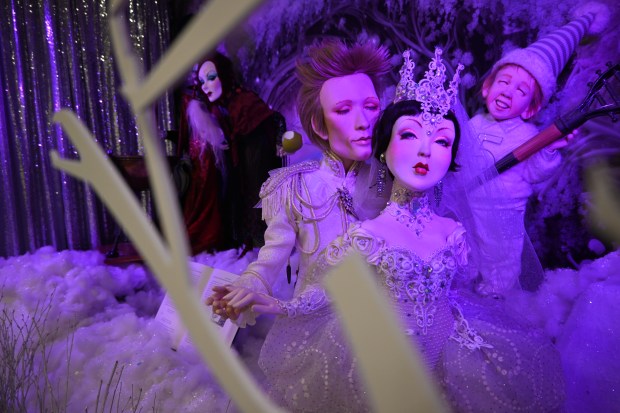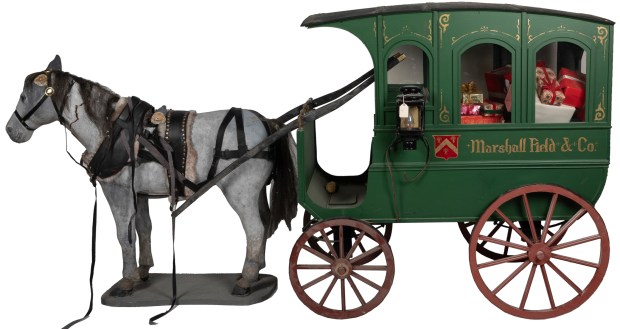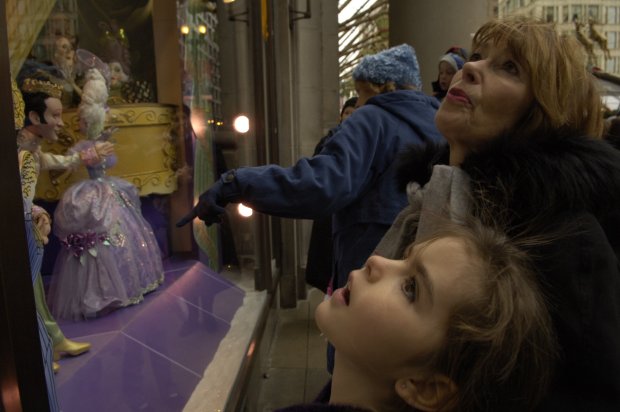It’s been nearly 20 years since anyone bought anything at a Marshall Field’s store, but the retailer still lives large in the Chicago area conscience.
The department store founded in the late 1800s was a regional destination throughout the 20th century, at its main State Street building designed by Louis Sullivan as well as its satellites beyond downtown and into the suburbs.
People loved the store, and the memories created during decades of visits, particularly during the holiday season.
That love was evident late last year when the Elmhurst History Museum opened an exhibit based on the book “Remembering Marshall Field’s and Lost Chicago Department Stores” by Leslie Goddard, according to Sarah Cox, the museum’s curator of exhibits.
“It was insane,” Cox said. “We had a line going out the door. A lot of people have that soft spot for Marshall Field’s.”
The exhibit featured other stores as well, including Wieboldt’s, Sears, Montgomery Ward’s and Field’s main State Street rival, Carson Pirie Scott, but one element in particular showcased the lasting legacy of Marshall Field’s. Automated figures from the store’s final elaborate holiday windows display on State Street were on loan from Macy’s, which inherited them when it replaced Field’s stores in 2005.
A Chicago tradition since the 1940s, the widow displays at Field’s State Street flagship became a holiday ritual for many families. Among those annual visitors were Cox, who said she heard about it almost immediately after moving as a child from Canada to west suburban Geneva.
“We used to take the train every holiday season downtown to see the Marshall Field’s windows, went across the street to Skate on State,” she said. “It was always a treat. Everyone had told us about these windows and how fabulous they were, so that became part of growing up. See the windows, go to the Walnut Room, get my Christmas mug — it was a whole experience.”
The Snow White figures on display in Elmhurst were the last commissioned by Field’s for its holiday windows. After Macy’s took over, resources were deployed elsewhere, and while displays have continued, they’re not as elaborate as those animated storyboards of bygone days.
“Snow White’s arms move, and the Wicked Witch’s cauldron lights up,” Cox said of the figures. “Now (in the store windows) the figures maybe spin or move back and forth, but it’s nothing like we used to see.”
The exhibit in Elmhurst was so popular, museum officials extended the exhibit for a few weeks, but when it eventually closed at the end of January, they returned the figures to Macy’s, which has a permanent 7th floor display of a few of the automatons.

You can’t buy the Snow White figures at Macy’s, but another set of automatons from the Marshall Field’s holiday heyday will be auctioned off in September.
Gabe Fajuri, president of Potter & Potter Auctions in Chicago, is working with the Griffin Museum of Science and Industry to sell 30 moving window display figures created in 1992 to help tell the fairy tale of Cinderella. Created in a Victorian era aesthetic, the figures depict men, women and pets, as well as a horse-drawn Marshall Field’s wagon, a scale reproduction of the store’s iconic State Street clock and other items. They are expected to fetch hundreds to thousands of dollars apiece.
Fajuri described the collection as “nostalgia combined with commerce combined with happiness.”
“These things are synonymous with all those warm and fuzzy feelings that we all have that time of year, and those kinds of expeditions to the Loop and its department stores,” he said.
The figures date to 1992, according to Fajuri. It was the second season of Cinderella’s three-year run at Field’s, but these characters were brought in to refine the displays. It was an opportunity to “work on the details, such as facial expressions and movements,” Field’s visual merchandising director Jamie Becker said in December 1992. The additions also featured new characters, such as the prince’s “pet afghan hound.”
One reason those kinds of window displays have gone by the wayside is the expense involved in putting together such elaborate presentations.
“When I was talking to the people at Macy’s I asked why they don’t do them anymore, and they said those windows today would cost about a quarter million dollars, and they don’t have that budget anymore,” Cox said.
It’s a surprising figure until one looks at what the displays involved.
“These are one-of-a-kind pieces,” Cox said. “They’re artworks in their own right. They have sentimental value, but they also have artistic and aesthetic value.”

For 45 years, the Field’s Christmas displays were the brainchild of Palos Heights resident Homer Sharp, who was called the store’s “decorations wizard” in his 1999 obituary. Among his creations were the Cozy Cloud Cottage and Uncle Mistletoe. Sharp was inducted to the National Association of Display Industry Hall of Fame in 1996.
The new Cinderella figures returned for an encore during the 1993 holidays at Marshall Field’s before being replaced the following year by window displays featuring a Pinocchio storyline.
Cox said stories such as Cinderella, Snow White and Pinocchio ended up in the windows because they were rooted in old fairy tales, rather than the popular Disney versions. That meant Field’s could avoid expensive licensing agreements.
Later in the 1990s, the store decided to modernize with popular contemporary stories, acquiring rights to develop displays based on books such as Harry Potter and Charlie and the Chocolate Factory. Those were the displays that were most memorable to Cox.
“The graphics were based on the books,” she said. “They did such a great job of recreating Roald Dahl’s character sketches.”
The 1992 automatons offered in the live auction Sept. 12 at Potter & Potter in Chicago aren’t immediately recognizable as being from Cinderella, and they’re not identified in the auction catalog as being specific characters from that story. Rather, they’re given generic titles such as “a standing Victorian gentleman” and “a boy with his begging dog.” They’re about 5-feet tall and in varying degrees of repair.
“Some work and some don’t,” Fajuri said. “Some may be more stationary at this point, but they’re not particularly complex when it comes to the mechanisms, so they’d be easy to repair.”

For Fajuri, the signature piece in the collection isn’t one of the animated people, but rather a miniature Marshall Field’s clock.
“To me, that’s quintessential Chicago — even more than just Christmas, it’s a piece of history,” he said. “Can you imagine what the original clock would sell for? This is about as close as you can get to owning that iconic item.”
The collection, as well as other items involved in the Coin Op and Advertising Sale, will be on display on auction day, Sept. 12, at the Potter & Potter gallery, 5001 W. Belmont Ave., where potential buyers and Field’s fans can see them one last time in person.
But it may not be the last time, Fajuri said.
“I wouldn’t be surprised if another attraction or more public entity might buy them to put them back on display,” he said.
“That’s the fun of the auction — where will it end up? Not only the physical location, but where the price will end up. Who knows, maybe people can buy them for $300 or $400 — the price of an expensive meal at a steakhouse. And if it goes crazy, maybe we’re adding zeros to those numbers. That’s what makes it fun and entertaining, unexpected and surprising.”
Landmarks is a column by Paul Eisenberg exploring the people, places and things that have left an indelible mark on the Southland. He can be reached at peisenberg@tribpub.com.





